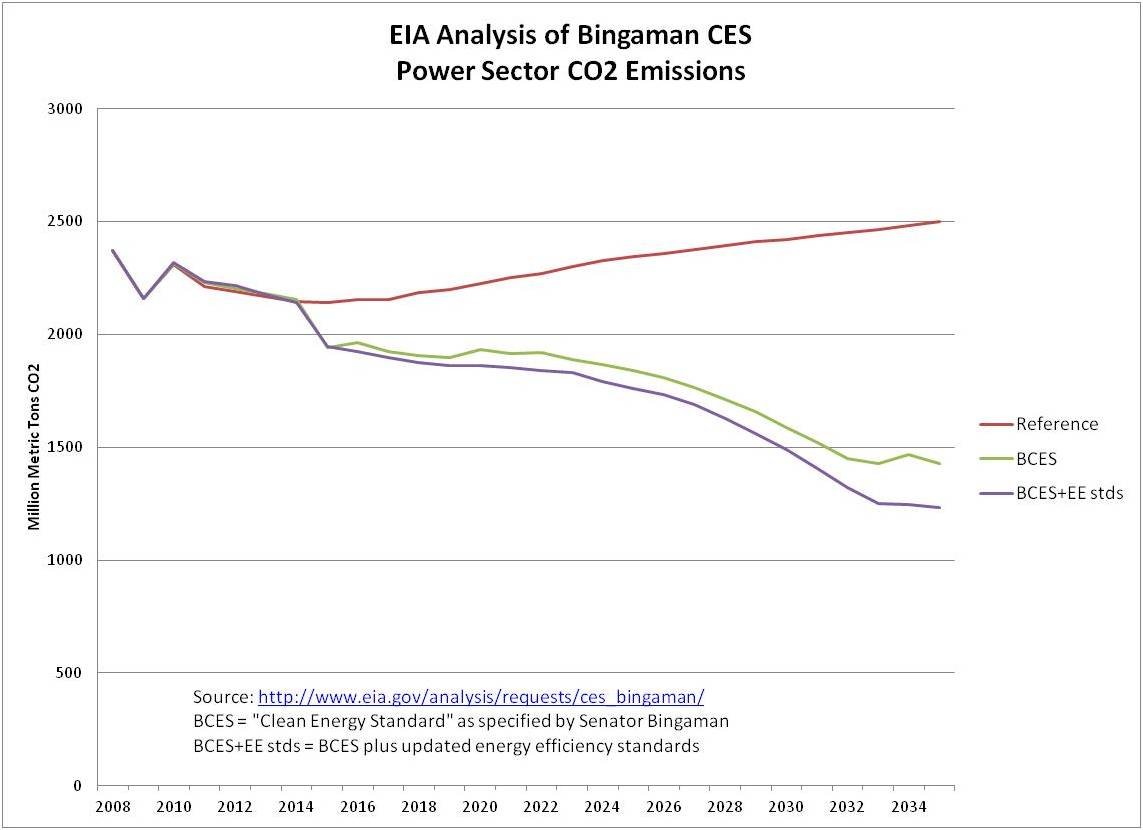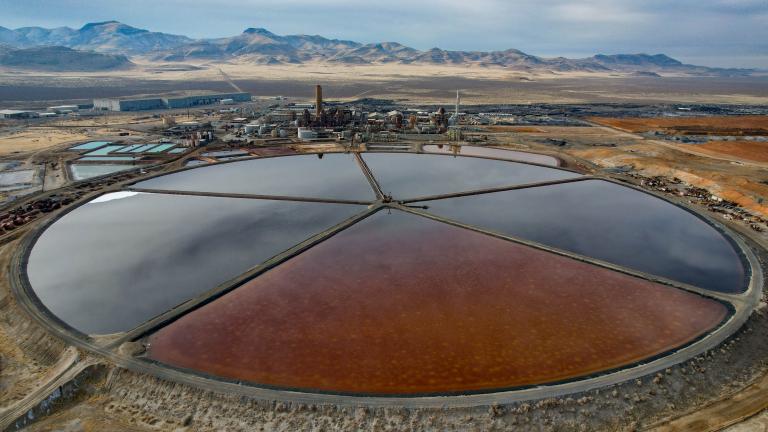This item cross-posted from NRDC’s Switchboard.
Willie Sutton is famously supposed to have said that he robbed banks because that’s where the money is (apparently this quote is apocryphal but it’s just too good to not keep using it). I have focused a number of recent posts on power plants because that’s where the carbon is (about 40% of the U.S. total). There is certainly no way to prevent even more dangerous changes to our climate without nearly eliminating carbon emissions from the power sector. That’s what makes a new report from the Department of Energy’s Energy Information Administration (EIA) so important. It analyzes one promising idea for driving this transition: a “clean energy standard” (CES) as proposed by Senate Energy Committee Chairman Jeff Bingaman.
According to EIA, which is hardly known for being optimistic about clean energy technologies, a CES combined with updated energy efficiency standards could reduce CO2 emissions from power plants 20% by 2020 while electricity prices fall by 7%. By 2035 CO2 emissions would be cut by almost half (see figure). By then EIA projects that electricity prices would be only 15% higher than in 2010, while per capita income would have increased by 49%. Of course, the cost of electricity 25 years from now depends on the pace of technological innovation and EIA tends to be quite conservative in making these assumptions. (My point of reference for all these calculations is 2010 levels as reported by EIA’s model. In its report, EIA generally compares a policy scenario with the CES in place to a reference case without it in order to isolate the effect of the policy, but the atmosphere and consumers will respond to actual emissions and prices.)

Before delving a little more deeply into the results of EIA’s analysis here’s some background on the CES policy. As Senator Bingaman specified it, the CES would require 50% of all electricity sales to come from “clean” sources by 2020 and 80% by 2035. As I have noted previously, “low-carbon” would be a far more accurate term than “clean”, and in fact Bingaman specifies that natural gas generation and generation from coal or gas with carbon capture gets partial credit based on its emissions relative to those of a supercritical coal plant. President Obama called on Congress to pass a Clean Energy Standard with these targets in his 2011 State of the Union address, although he never formally proposed detailed specifications. Joe Aldy subsequently proposed a CES with specifications similar to Bingaman’s in a Brookings Institution discussion paper.
One subtle, but important difference is that Aldy proposed allowing all existing low-carbon generation to produce clean energy credits, whereas Bingaman deducts generation from existing hydro and nuclear plants from the CES target. EIA has previously released an analysis of a CES that grants credits to these existing low-carbon sources at the request of Congressman Hall. As I explained in comments on that analysis, granting credits to these existing sources produces a windfall for them, while raising the cost impact of the policy. We now know by how much because EIA performed a sensitivity analysis on Bingaman’s proposal by changing just this feature. National-average electricity prices would increase 23% between 2010 and 2035 if credits are given to all existing hydro and nuclear plants, compared to 15% in the original Bingaman specification. Much bigger differences would occur at the regional level. Under Bingaman’s proposal EIA forecasts that regional electricity prices in 2035 would range from 5.9 cents/kWh (in Eastern Wisconsin) to 21.8 cents/kWh (on Long Island). With existing nuclear and hydro crediting the range would be 4.1-24.3 cents/kWh.
Turning back to Bingaman’s main proposal and assuming updated energy efficiency standards, how would electricity generators achieve the 47% reduction in CO2 emissions projected by EIA for 2035? First, electricity demand would increase by a total of only 12% between 2010 and 2035, compared to 24% in the reference case, mostly due to the updated standards. (Note that Synapse Energy Economics projects in its Transition Scenario, which has a similar CO2 emissions trajectory, that feasible energy efficiency measures could actually reduce electricity demand from current levels.) EIA projects that total renewable energy generation would increase by 250%, ending up with about equal contributions from hydro (which increases only 30% compared to 2010), wind, and biomass. (The Synapse scenario has a similar contribution from wind, but substantially more solar and less biomass.) Meanwhile, natural gas generation increases by 80% and coal generation falls by about 50%. (Natural gas generation does not increase nearly as much in the Synapse scenario, primarily due to lower overall electricity demand.)
One very controversial aspect of the CES as proposed by Bingaman (as well as Aldy and Hall) is that new nuclear power plants would count toward achieving the target. Of course that doesn’t mean that nuclear power would actually expand, given that it is much more expensive than other low-carbon options. In fact, with the Bingaman CES specifications and updated efficiency standards EIA projects that nuclear generation in 2035 would be lower than in 2010, although they do project 64 GW of new nuclear plants, offset by retirements and decreased output from the existing fleet. In the sensitivity case that grants credit to existing nuclear plants there is an incentive to keep them online and EIA projects that total nuclear generation would increase by about 40%. EIA has a history of being overly optimistic about nuclear power and that is likely to be the case here. Nonetheless, the analysis clearly shows that it’s possible to achieve the CES targets without expanding nuclear generation, contrary to claims by many nuclear advocates.
As I have discussed previously, the biggest drawback of a CES is that it requires Congress to actually pass legislation, something this Congress, at least, appears nearly incapable of doing. That’s not true of updating air pollution standards to limit carbon, mercury and other pollutants, nor of updating energy efficiency standards, nor of state energy efficiency and renewable energy programs, nor of local communities demanding that aging coal plants be replaced with cleaner options. EIA’s analysis provides a useful benchmark against which all of these efforts can be evaluated.
Cutting CO2 emissions 20% by 2020 while electricity prices decline would be a pretty good start.



